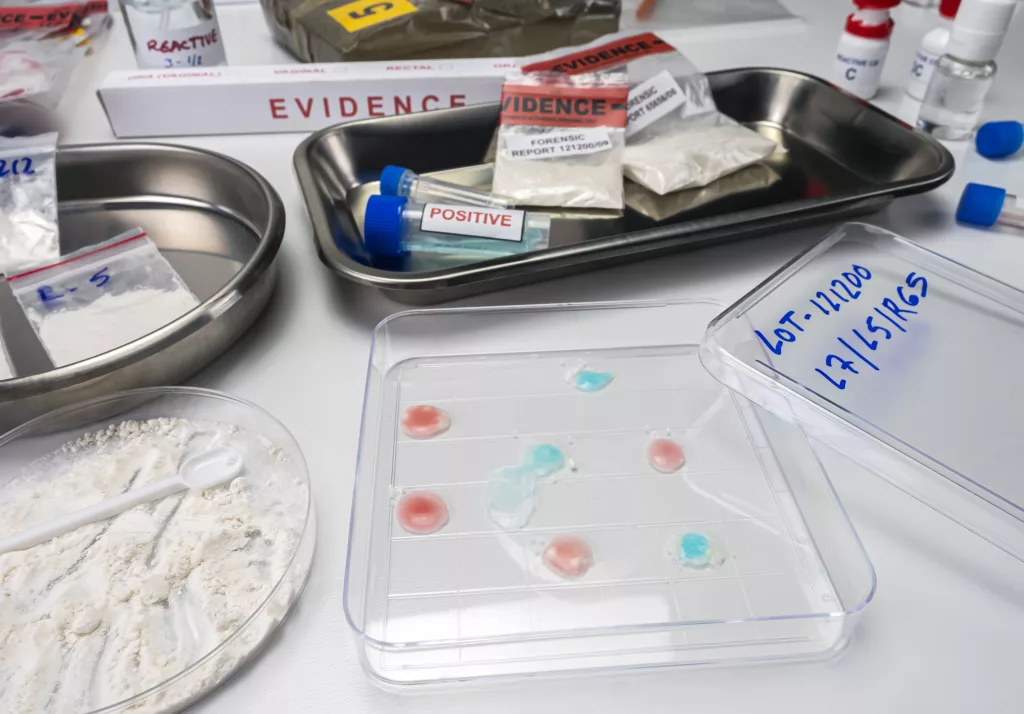
Pam Long examines the inconsistencies of drug testing as compared to alcohol or prescription drug use regarding preventing employment or terminating employment. Long challenges us to think about long term consequences of random mandated drug testing versus employee’s daily responsibility to show up to work ready to do their job unimpaired.
Imagine if there was a drug test that could detect if a person legally consumed a glass of wine while off duty a month prior to testing, and that test could be the basis for preventing employment or terminating employment. Or what if there was a test that detected that a person did not take an mRNA vaccine and the test determined employment eligibility? These are analogies for the current drug testing program for employment which includes cannabis disqualifications. There is no breathalyzer test or blood test for cannabis that can scientifically or legally detect intoxication or impairment. DUI arrests for suspected cannabis use are based strictly on visual signs, with a drug test administered later.
Recently I attended a Republican event where an attendee remarked that the current school bus driver shortages in Colorado are due to “too many people smoking weed.” This article will address the topic of school bus driver shortages and how cannabis testing affects employment, without alienating people who use cannabis legally. The trite remark of “too many people smoking weed” does not adequately analyze a complex issue, nor offer a solution in a state where medical cannabis is legal for both medical use and adult use.
Factors Contributing to Bus Driver Shortages
For context, the bus driver shortage is a national problem reported in all 50 states, even those that do not have legalized cannabis. There is also a national teacher shortage, and “smoking weed” is not the reason. The decade-long school bus driver shortage problem was exacerbated by the school closures during COVID-19 and the resulting layoffs and decreased demand for bus drivers. Many bus drivers retired early or found better hours, pay, hiring bonuses, retirement benefits and health benefits with Amazon and UPS. COVID-19 increased the demand for package delivery drivers, with the added bonus that the packages, unlike students, do not pose behavior problems for the driver.
The bus driver shortages are impacting schools which are not offering bus transportation in some situations and canceling field trips and sport competitions which require buses for large groups. One of the creative solutions include recruiting substitutes, mechanics, and retirees to fill in, and when necessary delaying the start of school to 10 a.m. to double routes of drivers. Some districts are expanding walk boundaries and creating new consolidated routes with fewer drivers, making much longer routes, with reports of students arriving at home at 10 p.m. Some states are offering a $300 stipend for parents to drive their students to school.
In Colorado, many districts are hiring expensive private companies to transport the students who are required by law to receive free school transportation: students with disabilities and students in temporary living situations (foster care and homeless). Last year, Denver spent $9.5 million and JeffCo spent $2.7 million on these private transportation companies such as EverDriven, HopSkipDrive. As reported by the Colorado Sun:
“The shortage of bus drivers in Colorado is also driving the expense, and some policymakers are questioning whether the state and school districts are handing money over to transportation companies that they should instead spend on recruiting and paying bus drivers. The legislature this year ordered the state Department of Education to convene a ‘transportation modernization task force’ to figure out what to do to protect students’ rights and, at the same time, not deplete school budgets.
‘Companies such as HopSkipDrive, EverDriven and Noah Care are being used to transport our students due to the perceived staffing crisis, a crisis created by low wages, subpar benefits and a lack of proper hiring practices such as advertising jobs at the incorrect pay rates,’ Trevor Byrne, a bus driver and president of the Jefferson County Transportation Association told the local school board. ‘What we don’t want is for this temporary Band-Aid to become a permanent solution.’”
With Douglas County’s 100 school bus driver shortages and lowest bus driver pay in the surrounding area, the district will implement rolling cancellations with four weeks on, and one week off, and still expect day-of cancellations for bus transportation.
The school bus driver problem will continue to get worse without making school bus driver recruitment a priority in school budgets. New York, Connecticut, and Ohio currently have school bus driver strikes as the workload increases on bus drivers without any increase in pay or benefits. In some cases, a 25-year bus driver only makes $0.59 more an hour than a first-year bus driver, making a wage of $22.09 an hour and working six hours a day. Loss of school transportation is directly linked to chronic absenteeism and education loss, and school funding is based on daily attendance.

Drug Testing Requirements for Commercial Driving Licensure (CDL)
According to the DMV, a commercial driver’s license for a school bus driver requires a Department of Transportation (DOT) medical exam and applicants can be disqualified for drug use, including cannabis.
According to the DOT (2012):
“We want to make it perfectly clear that the state initiatives will have no bearing on the Department of Transportation’s regulated drug testing program. The Department of Transportation’s Drug and Alcohol Testing Regulation 49 CFR Part 40 does not authorize the use of Schedule I drugs, including marijuana, for any reason. Therefore, Medical Review Officers (MROs) will not verify a drug test as negative based upon learning that the employee used recreational marijuana when states have passed recreational marijuana initiatives. We also firmly reiterate that an MRO will not verify a drug test negative based upon information that a physician recommended that the employee use medical marijuana when states have passed medical marijuana initiatives. It is important to note that marijuana remains a drug listed in Schedule I of the Controlled Substances Act. It remains unacceptable for any safety sensitive employee subject to drug testing under the Department of Transportation’s drug testing regulations to use marijuana.”
DOT aims to ensure that psychoactive impairment is not affecting commercial drivers, and yet the test that DOT uses cannot detect impairment.
CODOT affirms that the test cannot detect impairment:
“What if I have THC in my system because I consume cannabis frequently, but I’m not impaired and are pulled over tested? Psychoactive impairment is caused by active Delta 9 THC, which becomes inactive over time and is stored in the body for longer periods. The primary determinant is the driving behavior and observed level of impairment witnessed and documented by the law enforcement officer. Arrests are made on observed impairment. Any level of active THC in your blood can put you at risk of a DUI.”
CODOT even publicly states that people can test for high levels of THC in the blood, for weeks, and not be impaired:
“THC has been shown in past studies to impair cognitive and psychomotor performance essential to safe driving, a factor thought to at least double the risk of fatal motor vehicle accidents. The challenge for scientists, however, is that the concentration of THC in the body does not correspond well to functional impairment. One reason is that people who use cannabis often can have high levels of THC in the body and not be impaired. Another is that metabolites of THC can remain in the bloodstream for weeks after the last cannabis use, well beyond the period of intoxication.”
Medical News Today reports the confounding variables in cannabis testing detection: dose (strength increases detection), body fat (higher body fat increases detection), sex (women have more body fat), hydration (dehydration increases detection), and exercise (exercise increases detection). USAToday reported that people can false positive for cannabis by being in contact with a cannabis user and people can test positive for up to 90 days:
“Specific tests include urine, saliva, hair and blood tests, says Medical News Today. Urine tests detect weed between three and 30 days. Saliva tests generally detect cannabis within 24 hours but have been known to detect cannabis for up to three days after use. Hair tests can detect cannabis for up to 90 days but can give false positives if the person being tested was recently in contact with a cannabis user. Blood tests detect weed for three to four hours.”

Employers: A Positive Cannabis Test Does Not Legally Equate to Intoxication or Impairment
The short legal explanation by the National Association of Home Builders (NAHB) answer on how a cannabis positive test does not equate to cannabis impairment:
“There currently is no legally or medically accepted definition of what constitutes ‘impairment’ (or being ‘under the influence’ of marijuana). Unlike alcohol testing, impairment by marijuana cannot be objectively measured by any scientifically proven methodology. Current testing does not identify intoxication, only the presence of marijuana metabolites or THC, the psychoactive ingredient in marijuana. There is also no dispositive and complete list of symptoms of impairment.”
Indigent Defense Services provides a longer biological explanation on how cannabis testing is inconclusive compared to alcohol testing:
“Blood concentrations of THC and its metabolites are not sufficient to prove impairment. Testimony about additional signs of impairment is necessary to prove impairment.
The main reasons for the disconnect between THC blood concentration and impairment is that impairment occurs in the brain, not the blood, and the chemical nature of THC causes it to move throughout the body in a complex manner. Since blood and brain are different tissues, physically separated from each other, blood concentrations of any drug can only estimate the brain concentration and thus impairment.
For alcohol, the estimation of alcohol in the brain from alcohol in the blood is fairly accurate, because alcohol is highly water soluble and spends much of its time in the body within watery blood. However, estimation of brain concentration/impairment is very difficult with THC because it is more soluble in fat/oil than it is in water. This means that THC only spends a short amount of time within watery blood as it disperses throughout the body and deposits into more fatty tissues. High concentrations of THC reach the blood and brain shortly after smoking starts, causing impairment. Blood concentration decreases quickly after smoking stops, as no more THC is coming into the blood and what remains in the blood distributes into fatty tissue. The THC then stays in the fatty tissue for a long time, but small amounts will slowly leach out of fatty tissue and back into the blood over time, causing a continual low blood concentration.
This low concentration of THC in the blood is not enough to cause the high concentration in the brain needed for impairment. Most blood tests show relatively low concentrations of THC. Since this THC in the blood can be from both past use as well as recent use, it is not possible to differentiate between the two or infer impairment. Impairment by THC is currently best detected from the symptoms of impairment.”
Society for Human Resource Management, explains that employers need to understand that a positive cannabis test reflects only use, not impairment:
“[Mr.] Sample adds that tests only show whether someone has used marijuana—not if that individual is under the influence. ‘What you need to remember is it doesn’t matter if it’s urine, oral fluid or hair testing—it just reflects use,’ he says. ‘It doesn’t inform you whether someone was impaired or what their usage patterns are.’ The amount of tetrahydrocannabinol (THC) in marijuana determines its strength, and it can have vastly different effects on users depending on their body weight, method of consumption (smoking versus edibles) and patterns of use—occasional users compared to daily users, for instance.”
Society for Human Resource Management, also explains the paradox in cannabis testing is that daily, high concentration users can test negative, while occasional, low concentration users can test positive:
“These individuals reported that they used at least daily, multiple times per day, and half of their samples were negative—it was 19 hours between when they came in and we took the sample,” Huestis says. “We also found that in other users we could measure THC in the blood of chronic, frequent cannabis users at low concentrations for as long as 30 days.”
The users with longer-lasting traces of THC in their blood samples had what Huestis described as “huge body burdens,” where THC would remain in their fat cells for extended periods of time due to the nature of the compound. “THC is lipophilic. It likes fat,” she says.
Overall, the Society for Human Resource Management points to the need for policy reform on cannabis use and employment because the current testing does not legally equate to impairment:
“After U.S. states began legalizing the drug—first for medical use and later for recreational use—many employers began dropping marijuana testing from their preemployment screening, says Jane Terry, vice president of government affairs at the NSC.
Employers who are hiring for safety-sensitive positions, such as truck drivers or pilots, continue to test potential and current employees for marijuana. This is because these positions are subject to U.S. federal regulations, often under the U.S. Department of Transportation, that require them to conduct drug testing.
‘Truck drivers who have a Colorado license have to do testing, including for THC,’ Terry says. ‘That has not changed, but what we’ve seen from companies is there’s an increasing presence in THC in those operators and the cultural idea that—in this legal change for the states in America—marijuana use is okay. It’s affecting those who are required to be tested.’
And this again poses difficulties—just because someone tests positive for usage does not mean that they are impaired, Terry adds.
‘There is no scientific test for impairment of cannabis,’ she explains. ‘Policymakers and others think that because we can test for alcohol, it can be done for cannabis. But cannabis goes to your fat cells. Presence does not mean impairment—it can stick around for days or weeks. But because you can’t test impairment, it is really challenging for employers to figure out how to react if someone is using on the job.’”
Colorado Legislation & Executive Orders to Prohibit Cannabis Use Discrimination
In 2022, Colorado legislation passed a bill HB22-1321 to fund a study of devices to assess impairment by drugs other than alcohol. In 2022, Colorado failed to pass HB22-1152 “Prohibit Employer Adverse Action Marijuana Use,” which would have prohibited an employer from taking adverse action against an employee or applicant who uses medical cannabis during work hours or adult-use cannabis during non-work hours, with exceptions for employers with jobs that are dangerous and have occupational hazards. This bill was designed for people like Carolyn Edwards as reported by Denver 7,
“Carolyn Edwards lost her job last year over a positive drug test. Edwards has been a nurse anesthetist for 35 years. She suffers from a genetic condition that causes extreme pain at times. To manage the pain, Edwards started using a CBD product known as Charlotte’s Web. However, the THC from the product showed up in a drug test. ‘I don’t use THC, I don’t use marijuana. I was simply using an over-the-counter, legal medicine that had 0.1% THC, which resulted in a positive drug screen,’ she said. ‘Even my doctor said that CBD is the best medicine for my disease.’ Edwards was placed on administrative leave for two weeks before being asked to sign a form admitting that she used drugs. She says the form also required her to agree to random drug tests for a year and to attend monthly drug rehabilitation counseling. She refused to sign the paper and her employment was terminated.”
This bill failed to become law in 2022, so on July 14, 2022 Governor Polis issued Executive Order D-2022-34 “Protecting Colorado’s Workforce and Expanding Licensing Opportunities:”
“The exclusion of people from the workforce because of marijuana-related activities that are lawful in Colorado, but illegal in other states, hinders our economy and our State. No one who lawfully consumes, possesses, cultivates or processes marijuana pursuant to Colorado law should be subject to professional sanctions or denied a professional license in Colorado. This includes individuals who consume, possess, cultivate or process marijuana in another state in a manner that would be legal in Colorado. Colorado will not cooperate with out-of-state investigations related to disciplinary action against a professional license, certification, or credential for marijuana-related actions that are lawful in our State. This Executive Order ensures that all Coloradans are afforded protections and rights under Colorado law and directs the Colorado Department of Regulatory Agencies (DORA) and the Colorado Department of Revenue’s Specialized Business Group and Marijuana Enforcement Division (DOR) to protect Colorado’s workforce by ensuring Coloradans’ professions are not in jeopardy as a result of lawful marijuana-related conduct.”
Then in 2023, Colorado legislation passed a bipartisan bill in SB23-265 “Prohibit Professional Discipline for Marijuana,” which protects the professional license, certification, or registration from disciplinary action for lawfully using cannabis. I called various employees at Colorado DOR, CODOT, DMV, and the Commercial Driver’s License Unit, and strangely not one state employee would clarify if a positive cannabis test disqualified applicants for a school bus driver’s license. Without this clarification, people assume when state laws are in conflict with federal laws, such as federal guidelines for drug testing with prohibitions against cannabis use for commercial drivers, pilots, and military members, then federal guidelines prevail.
Conclusion
People can become impaired drivers by many over-the-counter drugs (Benadryl) and prescribed drugs (Xanax), but the government does not test applicants for use of these drugs or drug interaction. Legally and scientifically, impairment for cannabis is judged by visual symptoms, not a drug test. Moreover, an annual drug test does not prevent impairment on any workday throughout the other 365 days of the year. Dispatchers of commercial vehicle fleets are responsible for ensuring that drivers are not impaired on a daily basis when reporting to work. As a matter of the proper role of government and potential for future violations of medical freedom, the public should scrutinize if the government can mandate any medical test that disqualifies a person from employment based on a positive or negative result. It is a slippery slope to give government power to institute a mark of approval for people to exercise their right to participate in employment and commerce. Local control would empower employers to decide if applicants are impaired or non-compliant in a medical mandate which impacts their specific job











